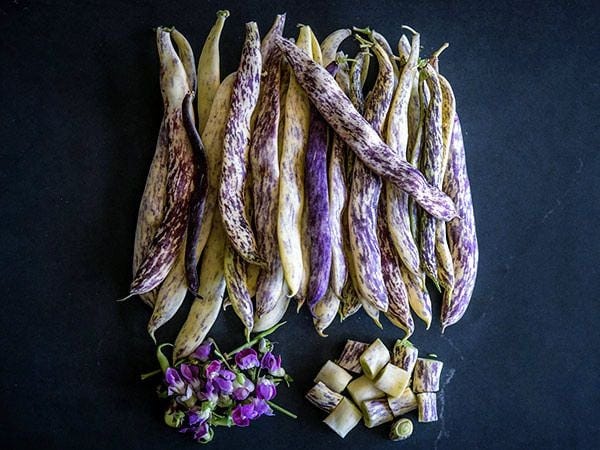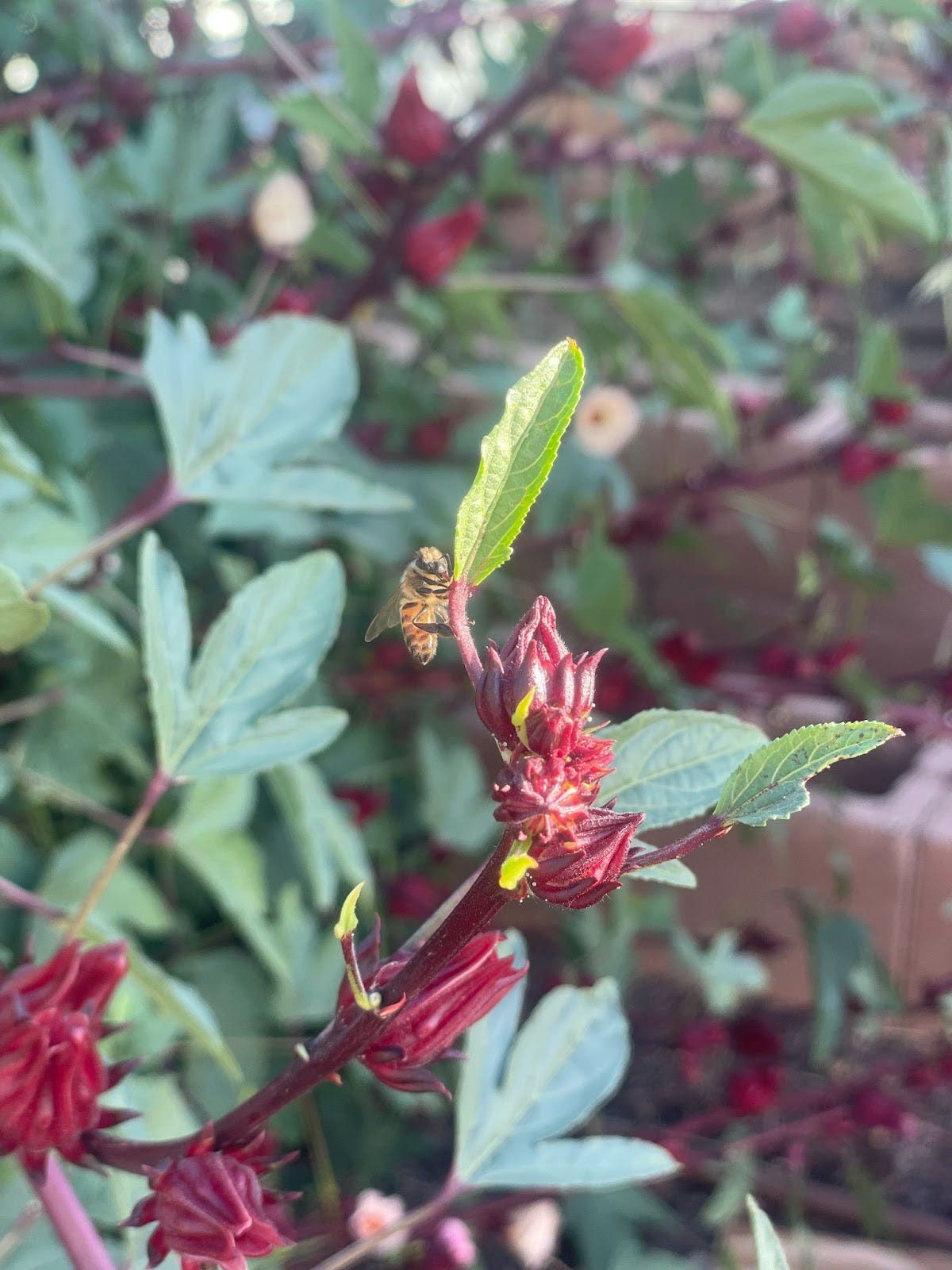A Beginner's Guide to Gardening
Whether you have an apartment patio or an acre, it's never too late to start growing your food
After years of living in a big city with no outdoor space, moving to Arizona felt like a breath of fresh air. Not only did I have sun all year round, but I finally had the outdoor space to start my garden!
Granted, our outdoor space was a concrete slab in the middle of a busy downtown area, but it was more than I had ever had coming from a one-bedroom apartment in the heart of DC. I was bright-eyed and bushy-tailed knowing some sort of outdoor space was all I needed to start growing my produce.
Despite popular opinion, you don’t need 10 acres, 3 acres, or even 1 acre to start gardening. You only need access to a space outside where you can put a pot or two. You don’t even need grass or dirt!
Why should you grow your food?
When you grow your food, you know exactly what goes into it. From the variety of plants, to water, to nutrients, to fertilizer, to the lack of pesticides- you are the one making those decisions. Unfortunately, we can’t depend on the labels we find at the grocery store anymore.
While they may read “organic” or “local”, what does that even mean? Regulations vary greatly in the practices they cover and what they allow. Not to mention, large corporations, especially big agriculture, cannot be trusted. They are now spraying chemicals like Apeel on their produce to maintain freshness and extend an already prolonged shelf life.
Unless you see the plant growing, and how the particular farmer is treating and transporting it, you can’t guarantee anything about what you are eating. This is why gardening is so great- there are never any surprises about your food.
Not to mention, gardening also helps with the issue of food security. If you have the skills to be completely self-sustainable and grow your own food, the government can’t tell you what to eat or not eat. We are already seeing a shift in countries dictating how much meat its people can eat. What makes you think they won’t be coming for fresh, organic fruits and vegetables next?
Don’t be naive- start learning the skills you need to keep your family healthy and well-nourished.
Start with finding your growing region
When I first started gardening, I planted whatever transplants I could find at my local nursery. I assumed that whatever they had was appropriate to plant in that season. Well, this was the wrong assumption to make.
I was growing romaine lettuce and strawberries in June in Arizona when it is over 100 degrees Fahrenheit every day. This was way too hot for these plants and led to them dying fairly quickly. I was frustrated and thought I was doing something wrong.
But really, I had set myself up for failure from the very start. When starting a garden, the very first thing you should do is look up your plant hardiness zone. Depending on where you live, you are assigned a certain zone which denotes what crops can be planted and when to plant them.
This is essentially a gardener’s bible. You can then use this zone to find gardening blogs, planting guides, and even seed companies with seeds specifically for your climate.
Above Ground Container Growing
After figuring out your plant hardiness zone, it’s time to find the container that will house your crops! Find one based on the size of the outdoor space you have available to you. This could be one pot or a 5-foot-long above-ground container. Make do with the space you have!
You can find above-ground containers at hardware stores like Lowes or Home Depot, or, better yet, built by locals at the farmers market or on Facebook marketplace. We found our original above-ground garden container on Facebook marketplace, built by a local couple who also customized and built them completely by hand (yay for supporting true artisans!).
The material doesn’t matter as much as long as the container has good drainage for the soil that you will be putting in it. To increase drainage, you can lay something like vermiculite at the bottom but this isn’t always necessary. I recommend starting simple and then adding on if you feel you need it!
Soil
Next, make sure you buy a high-quality, organic container gardening mix. You want to look for equal parts nitrogen, phosphorous, and potassium. These ratios are typically denoted at 10-10-10, or 5-10-5, to represent the parts of each nutrient. If you don’t want to think about ratios, look for a mix specific to what you want to grow. If you’re looking to grow vegetables, make sure the mix supports vegetable growth! If you’re growing flowers, the nutrient ratios may be a bit different, so look for a mix specific to that.
I recommend looking to see if you have a local nursery that creates its own mixes. Here in Phoenix, we have a place called the Arizona Worm Farm which uses worm castings to make an extremely nutrient-rich mix. If there’s something like this by you, that’s a great place to start!
Water
Watering can be tricky. If you’re anything like me, you forget to water your plants for 4 days straight and when you finally remember, everything is dead. For this reason, if you have a big enough space, I recommend setting up some sort of automatic watering system. This is also ideal for those who like to travel and may be gone for a week at a time.
We were lucky enough to have a water system already built into our garden, but you can build one yourself using garden hoses and a hose timer. Or, if you have smaller pots, you can use something called an olla or watering globe to slowly release water into the soil.
And, if you can remember to water your plants, more power to you! Find yourself an aesthetic War Kitchen-approved watering can and build the practice of watering your garden into your morning routine. Just be sure to read the back of the seed packets to make sure you aren’t overwatering your plants (yes, that’s a thing)!
Transplants vs Seeds
Hands down, the most fun thing about gardening, is choosing what to grow each season. The options are truly endless. At the grocery store, you see the same old boring variety of vegetables every single day. With seeds, you can choose different colored flowers, heirloom vegetables, weird-shaped squash, and varieties you’ve never heard of.
We’re currently growing dragon tongue heirloom beans in our garden. They are heirloom Dutch beans dating back to the 19th century. I mean, how beautiful are these?
With gardening, you choose whether you want to start from seed or transplant. This is how any decision on what to grow starts. Transplants are seeds that have already been planted and have reached a stage where they are stable. They are a good place for beginners to start.
Seeds can be more finicky as they need proper water and sunlight to sprout. In general, they are more susceptible to harsh weather conditions or disease since they aren’t yet established.
Many long-term gardeners start seeds inside, using heating pads and sunlight lamps to help them grow into a strong enough sprout that can then be planted outside. Personally, I have yet to embark on this journey. I don’t think you need to do that when you first start to be successful.
Try to grow some plants from seed and also pick out some transplants at the local nursery. See what works for you! The fun in gardening is the experimentation process.
With this, it’s also important to reference your plant hardiness zone. Depending on your zone, it will be recommended to start certain plants from transplant rather than seed. For example, in Zone 9b, it’s recommended to plant tomatoes from transplant only. Because of this, we’ve gone to the Worm Farm to buy tomato transplants each season and they’ve been wildly successful. However, we’ve also broken “the rules” with cucumbers, growing them from seed. They ended up super strong and healthy! Again, experimentation.
Here are some seed companies I’ve bought from and have had success with:
When buying seeds, I tend to opt for non-GMO, organic seeds, choosing heirloom when possible.
Harvesting
There’s nothing more rewarding than the first fruit or vegetable on a plant you’ve been growing for weeks or months. Talk about delayed gratification! When you harvest the fruits of your labor, it will taste way better than anything you’ve ever had at the grocery store. You’ve nurtured it, given it love, and appreciated it every step of the way.
In terms of knowing when to harvest, I do a quick Google search on whatever plant I’m growing, looking for some guidance. I always find the answer I need along with more tips on how to keep the plant steadily producing.
Since my very first garden in the concrete jungle of downtown Phoenix, we’ve since upgraded to half an acre in a more “suburban” part of town. We have 7 large garden beds that are sometimes too much space to know what to do with. We’ve been experimenting with planting different vegetables and flowers, having fun with it, and learning as we go.
Currently, three of our garden beds are exploding with roselle hibiscus. I’ve quickly fallen in love with the roselle hibiscus plant and the bees and hummingbirds it attracts. I’m currently in the process of learning how to prevent mold from growing on a lot of the calyxes (which is the part of the plant that you eat).
Gardening is by no means easy- this challenge is eating away at me! You spend so long nurturing these plants that you want the harvest to be bountiful. And having to toss beautiful fruits away to mold is devastating…
But the reward of eating what you grow, and getting to share that with friends, family, and your community makes it all worth it in the end. You can feel confident knowing what you eat has come from your backyard, left zero negative footprint on the Earth, and is organic and as nutrient-dense as possible.
You don’t have to start big- start with one pot and one transplant. Choose an herb, vegetable, or fruit that you regularly buy at the grocery store. Nurture that plant and let it replace a regular staple in your diet.
And remember, every gardener starts somewhere! Once you begin, you’ll gain the confidence to continue growing. And you might fall in love with it like I did.
Enjoy your Sunday!
Madison
PS: We are officially married!









CONGRATULATIONS 🥳
IT'S A BEAUTIFUL PICTURE
I grew tomatoes and herbs on my deck this year and I really enjoyed it and I can see the benefits of it and I agree with you.
That's all you have to work with then make it work ‼️